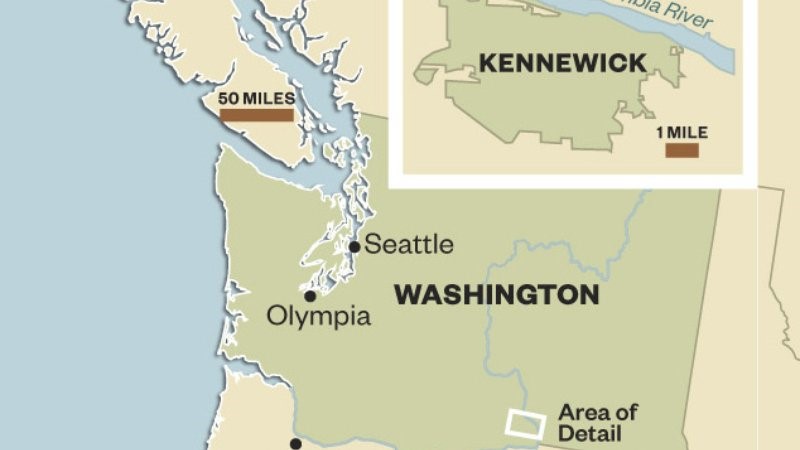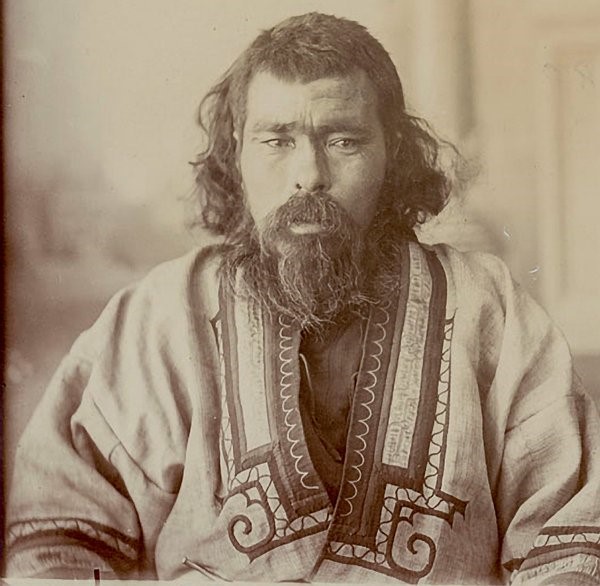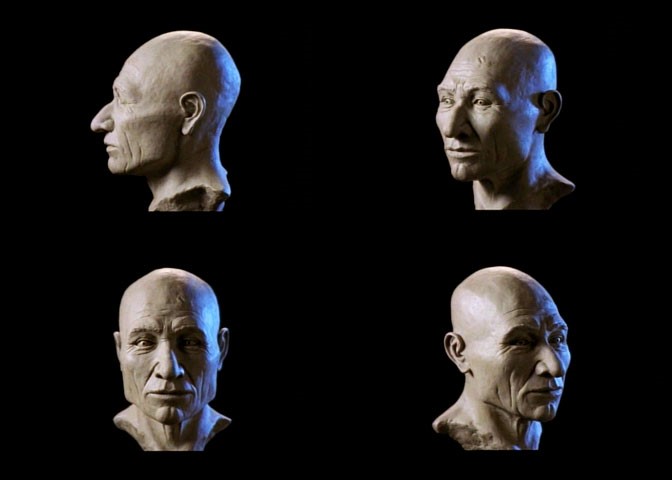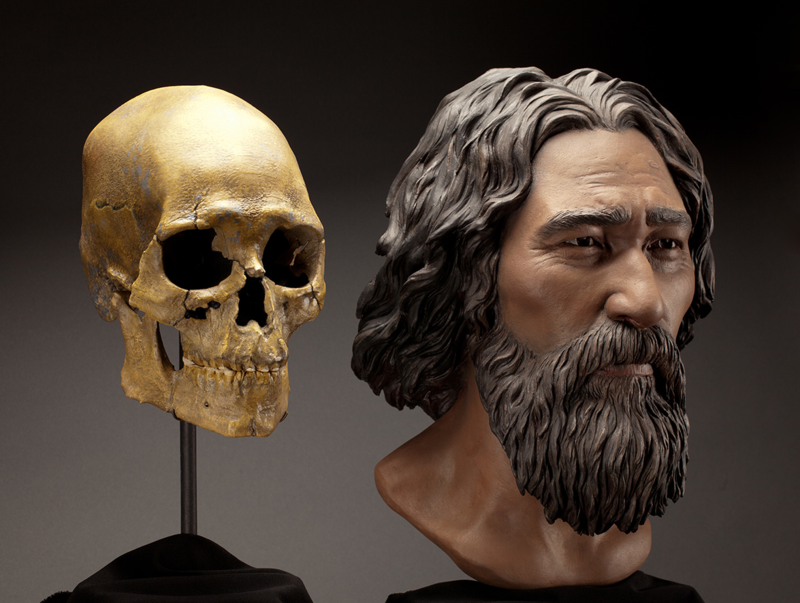Kennewick Man / The Ancient One
by Stefan Krause, last edited 01/11/2017.
Summary
Kennewick Man—among Native Americans known as the Ancient One – is a name for the skeletal remains of a male Homo sapiens discovered in the State of Washington, USA, in 1996. Studies based on radiocarbon dating suggest that Kennewick Man died around 8,400-8,690 calibrated years before present.[1] Because the remains of Kennewick man were in such excellent condition and almost complete, this skeleton opened many doors to the further understanding of not only the migration patterns by the earliest humans, but also geological conditions dating far into the past (e.g. Bering land bridge).
Due to the great age and the unclear origin of the Kennewick Man, many legal and scientific battles have surrounded his cultural affiliation. The major debate about the rightful ownership of the skeleton was carried out between representatives of Native American tribes, who requested to repatriate the remains according to the Native American Graves Protection and Repatriation Act (NAGPRA)[2], and members of the scientific community demanding an open access to the skeleton and further scientific examination. A study of Kennewick Man’s genome, published in 2015 by a team of scientists from the University of Copenhagen, revealed that the find is clearly related to Native Americans, most closely to the Colville Tribes.[3] Hence, the battle over these ancient bones illustrates the Western desire for an ancient European presence in America and it shows the residual difficulty among some scientists to accept indigenous assertions and narratives about their ancient land tenure.
Discovery and Reconstruction
In July 1996, two college students were at the riverbank of the Columbia River to watch the hydroplane race in Kennewick, Washington.
During the walk through the shallow water they accidentally discovered one of the most important finds in the history of American archaeology – the skull of Kennewick Man or the Ancient One.
In the evening of the very same day the local coroner Floyd Johnson contacted archaeologist and paleontologist James C. Chatters, who helped to recover even more bones at the site. After his first evaluation of the find, he was amazed by the “completeness and unusually good condition of the skeleton, presence of caucasoid traits, [and] lack of definitive Native-American characteristics.”[4] The good state of the remains made it easier for scientists to shed light on the spectacular find. Closer looks at the structure, shape, and condition of the bones provided the opportunity to make statements about the person’s age-at-death, sex, diet, and possibly his cultural affiliation.
Many early investigations focused on the skull. Characteristics of the skull are often specific for people from the same or closely related populations. However, even among these populations skull patterns show a certain range. This makes it difficult to allocate a single skull to a group of people. Concerning Kennewick Man, Chatters observed a narrow and prognathous face, with a long and broad nose, and interpreted these as caucasoid features.[5] Subsequent analyses of the skull (craniometrics) indicated a connection to the Moriori people from Polynesia or to the ancestors of the Ainu from the region around Japan.[6]
In the context of these craniometric investigations, scientists also produced facial reconstructions of Kennewick Man. These reconstructions ranged from Chatter’s and McClelland’s famous Patrick Stewart (Star Trek: The Next Generation) lookalike[7] to more recent models such as the one created by Douglas W. Owsley and his team.[8]
Examining the bones, Chatters and his colleagues were also able to reconstruct details about Kennewick Man’s life. His analysis showed that the remains belonged to a male aged 40-55 and 170-176 cm tall.[9] The bones also revealed that the person had arthritis and suffered injuries to the chest, the right arm and shoulder, and “a blow to the head.”[10] However, the most interesting part about Kennewick Man’s long list of injuries was a small stone object found in his hip. Chatters identified the object as a “serrated Cascade projectile point typical of Southern Plateau assemblages from 8500 B.P. to 4500 B.P.”[11] Dating the projectile point found close to the human remains—a common method of archaeology to determine the age—hinted at the antiquity of the find. Suddenly there was the possibility that Kennewick Man was very old.
In order to get a better idea of the skeleton’s age, radiocarbon tests and DNA analyses were conducted. One of the first radiocarbon tests dated the find back to 8,340-9,200 calibrated years before present (BP).[12] After these first official dates had been published, the interest in Kennewick Man increased rapidly. Scientists hoped that the find would provide evidence on whose ancestors lived in North America more than 8000 years ago. Several Native American tribes saw the proper burial of an ancestor at stake. Soon the Walla Walla District Corps of Engineers—being responsible for the land where the skeleton was found—announced their intention to terminate any further scientific investigation, referring to the Native American Graves Protection and Repatriation Act (NAGPRA, 1990), which governs the return and reburial of finds clearly related to the indigenous population. Instead, it was intended to return the remains to an alliance of Native American tribes and bands from the Columbia River Basin, including the Colville, Wanapum, Umatilla, Nez Perce, and Yakama tribes.[13] Some members of the scientific community did not accept this decision and thus the battle over the bones of the Ancient One began.
The Battle over Bones
Numerous fractions claimed the rights for the remains of Kennewick Man. Among those there were also groups like the Asatru Folk Assembly, an American organization, allegedly practicing a kind of Celtic religion. Several Native American tribes insisted that the Ancient One was their ancestor, and demanded repatriation and a proper burial according to NAGPRA. Representatives of the Umatilla tribe explicitly referred to their oral histories, pointing out that their “people have been part of this land [the Columbia River Basin] since the beginning of time.”[14] The Confederated Tribes of the Colville Reservation (Colville Tribes) even filed their own claim. Many archaeologists and other scientists argued that this ancestral link did not exist and that the skeleton should hence be made available to the public for scientific investigation. Similar to many other cases in the history of American Anthropology, this conflict was based on two fundamentally different understandings of how to handle ancient bones. The indigenous population intended to rebury the remains in a religious ceremony, whereas white scientists were primarily interested in using the remains as evidence for theories of ancient migration.
Considering the age of the remains, the Corps of Engineers held the Native American ancestry of the find as evident.[15] After the Corps had decided to return the skeleton to Native American tribes, a group of eight archaeologists including Douglas W. Owsley filed a lawsuit based on the claim that the remains are not related to Native Americans since their research suggested Kennewick Man’s connection to early Asian populations. In February 2004, Judge Gould of the United States Court of Appeals for the Ninth Circuit ruled that NAGPRA does not apply in this context since the age of the find and the limited knowledge about this era make it impossible “to conclude reasonably that Kennewick Man shares special and significant genetic or cultural features with presently existing indigenous tribes, people, or cultures.”[16] The floor was open again for scientific study.
In July 2005 and February 2006, Owsley and a team of archaeologists gathered and examined the remains for 16 days.[17] They published their results in September 2014 in Kennewick Man: The Scientific Investigation of an Ancient American Skeleton – a bulky tome combining anthropological, archaeological and geological perspectives. The book recreates the Ancient One’s life and death on the basis of his cranial structure and assumptions about his diet. Yet, as David Meltzer points out, “[a]s to whom Kennewick Man might be related, the answer in Kennewick Man differed by degree – but not in kind – from what had been claimed by Chatters more than a decade before.”[18] The study still clings to the nineteenth-century method of craniometric measurements which is used to demonstrate Kennewick Man’s circum-Pacific origin. Furthermore, the authors of Kennewick Man depict him as a traveler, which Meltzer interprets as another attempt to perpetuate the notion that the Ancient One was an immigrant from another land.[19] In fact, the book argues that he was of Ainu descent, based on the similarity of their most recent reconstructions of his skull and old photos of Ainu. The whole book is driven by a strong desire to prove that Kennewick Man was a transpacific migrant and ethnically unrelated to Native Americans. This is particularly delicate, considering that in old racial theories the Ainu are regarded to be of Aryan descent, not Mongolian.[20] However, this story began to crumble when DNA analysis finally yielded usable results.
In July 2015, a group of scientists around the Danish archaeologist Morten Rasmussen and evolutionary geneticist Eske Willerslev, published a paper that clearly links the skeleton to modern Native Americans.The scientists extracted genetic material from Kennewick Man’s metacarpals and sequenced parts of his genome. In their analysis they compared the sample’s DNA with genetic material from populations around the world. The comparison revealed “a clear genetic similarity to Native Americans”[21] and lead the team to reject any theories of a possible close relation to European or Polynesian populations. In order to narrow down Kennewick Man’s ancestry, Rasmussen and his colleagues also compared the recovered DNA to the genome of three Native populations from different parts of the Americas (the Colville Tribes from the American Northwest, the Athabascan tribe from Canada, and the Karitiana tribe from Brazil). The test results suggest that out of the three groups, the Colville tribe has the greatest genetic connection to Kennewick Man. Yet, scholars acknowledge that due to a lack of genetic samples from many Native American tribes, it is currently impossible to determine the closest living relatives.[22] After the DNA results had been released, the claimant tribes and U.S. Senator Patty Murray introduced the Bring the Ancient One Home Act, which was integrated into a bill and passed in December 2016.[23] After twenty years of legal and scientific debates, the Ancient One was repatriated to the tribes and buried at an unknown location on February 18, 2017.[24]
In the end, the story of this ancestor has been dominated by Western science. The power of the scientific ‘fact’ has favored narratives proposing a settlement of the Americas by Asians or Europeans. These narratives often seem to legitimize former colonial politics and spark hope for an American antiquity. However, it seems unreasonable to neglect Native American oral traditions or to reject theories arguing that the ancestors of modern indigenous people have lived in the Americas since ancient times. In the context of Kennewick Man, it took years and the approval of Western science until the Native American narrative has been accepted.
NOTES
[1]Owsley, Douglas W., and Richard L. Jantz, eds. Kennewick Man: The scientific investigation of an ancient American skeleton. College Station: Texas A&M University Press, 2014.
[2] National Park Service, “National NAGPRA,” U.S. Department of the Interior, www.nps.gov/nagpra/mandates/25usc3001etseq.htm (access date 10/06/2015).
[3] Rasmussen, Sikora, et al. “The ancestry and affiliations of Kennewick Man.” Nature 523.7561 (2015): 455-58. Web.
[4] Chatters, James C. “Kennewick Man,” Smithsonian Institution, www.mnh.si.edu/arctic/html/kennewick_man.html (access date 10/06/2015).
[5] Chatters, “Kennewick Man.”
[6] Preston, Douglas “ The Kennewick Man Finally Freed to Share His Secrets,” Smithsonian Magazine,www.smithsonianmag.com/history/kennewick-man-finally-freed-share-his-secrets-180952462/ (access date 10/08/2015).
[7] Chatters, James, “Meet Kennewick Man,” PBS, www.pbs.org/wgbh/nova/tech/meet-kennewick-man.html (access date 10/09/2015).
[8] Owsley and Jantz, eds. Kennewick Man.
[9] Chatters, “Kennewick Man.”
[10] Kelly, Robert L., and David H. Thomas. Archaeology. 5th ed. Belmont, CA: Wadsworth, 2010, Introduction.
[11] Chatters, “Kennewick Man.”
[12] Taylor, Kirner, et al. “Radiocarbon Dates of Kennewick Man.” Science 280.5367 (1998): 1171c.
[13] Chatters, “Kennewick Man.”
[14] Preston, “The Kennewick Man Finally Freed to Share His Secrets.”
[15] Slayman, Andrew, “Special Report: A Battle Over Bones,” Archaeology, archive.archaeology.org/9701/etc/specialreport.html (access date 10/13/2015).
[16] Society for American Archaeology, “BONNICHSEN v. UNITED STATES,” The United States Court of Appeals for the Ninth Circuit, www.saa.org/Portals/0/SAA/repatriation/Gould.2004-02-04.pdf (access date 10/08/2015).
[17] Preston, “The Kennewick Man Finally Freed to Share His Secrets.”
[18] Meltzer, David J. “Kennewick Man: Coming to Closure.” Antiquity 89, 348 (2015): 1485-1493. 1487.
[19] Meltzer, David J. “Kennewick Man: Coming to Closure.” 1487.
[20] Chisholm, Hugh, ed. (1911). "Ainu". Encyclopædia Britannica. 1 (11th ed.). Cambridge University Press. pp. 441–442.
[21] Rasmussen et al. “The ancestry and affiliations of Kennewick Man,” 456.
[22] Rasmussen et al. “The ancestry and affiliations of Kennewick Man,” 458.
[23] Rosenbaum, Cary. “ELDER SERIES ARTIFACT: The Bone Protector, Adeline Fredin.” Tribal Tribune, 18 Feb. 2017. www.tribaltribune.com/news/article_e1a350ea-f47b-11e6-9c90-439d6d290bac.html. Accessed 21 Feb. 2017.
[24] Rosenbaum, Cary. “Ancient One, also known as Kennewick Man, repatriated.” Tribal Tribune, 18 Feb. 2017. www.tribaltribune.com/news/article_aa38c0c2-f66f-11e6-9b50-7bb1418f3d3d.html. Accessed 21 Feb. 2017.
FURTHER READING
Burke, Heather. Kennewick Man: Perspectives on the Ancient One. Walnut Creek, Calif: Left Coast Press, 2008.
Burke Museum of Natural History & Culture, “Kennewick Man/The Ancient One,” www.burkemuseum.org/kennewickman (access date October 6, 2015).
Chatters, James C. Ancient Encounters: Kennewick Man and the First Americans. New York: Simon & Schuster, 2001.
Meltzer, David J. “Kennewick Man: Coming to Closure.” Antiquity 89, 348 (2015): 1485-1493.
National Park Service, “National NAGPRA,” U.S. Department of the Interior, www.nps.gov/nagpra/mandates/25usc3001etseq.htm (access date October 6, 2015).
Owsley, Douglas W., and Richard L. Jantz, eds. Kennewick Man: The Scientific Investigation of an Ancient American Skeleton. College Station: Texas A&M University Press, 2014.
Rasmussen, Sikora, et al. “The Ancestry and Affiliations of Kennewick Man.” Nature 523.7561 (2015): 455-58. Web.
Thomas, David H. Skull Wars: Kennewick Man, Archaeology, and the Battle for Native American Identity. 1st ed. New York, N.Y: Basic Books, 2000.
Walker, Sally M., and Douglas W. Owsley. Their Skeletons Speak: Kennewick Man and the Paleoamerican World. Minneapolis: Carolrhoda Books, 2012.
ILLUSTRATIONS
Figure 1: Simon, Jamie, thumbs.media.smithsonianmag.com//filer/4c/a9/4ca9ad25-4849-413f-9019-863a288a2749/sep14_d99_kennewick.jpg__800x450_q85_crop_upscale.jpg (access date 10/08/2015).
Figure 2: Adapted from: Pilsudski, Bronislaw (1909), DOE Asia: Japan: Ainu: NM 50618 04734600, National Anthropological Archives, Smithsonian Institution, sirismm.si.edu/naa/97/asia/04734600.jpg (access date 01/14/2016).
Figure 3: WGBH Educational Foundation, www.pbs.org/wgbh/nova/tech/meet-kennewick-man.html (access date 10/09/2015).
Figure 4: Tatchell, Brittney, Smithsonian Institution, newshour-tc.pbs.org/newshour/wp-content/uploads/2015/06/kennewick-man-SI.png (access date 10/09/2015).




